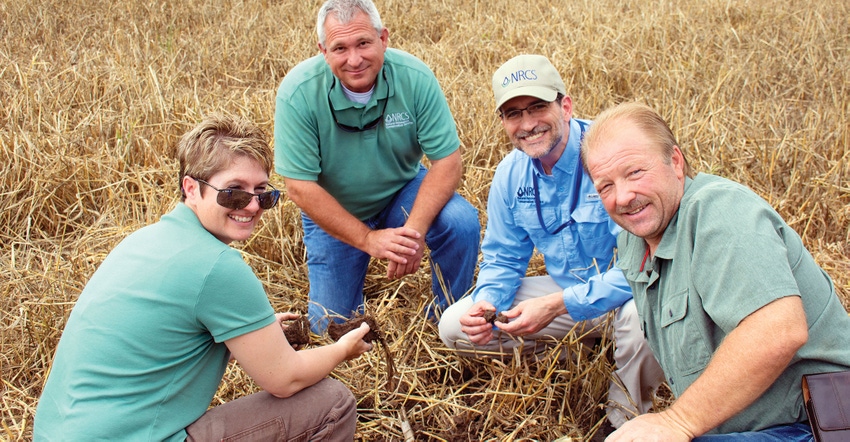
Crop rotations have been practiced for thousands of years. The benefits are well-documented and universally accepted. The mechanisms for success were not always well understood. Only recently, however, with the new emphasis on soil health, have researchers begun to answer this lingering question.
At the heart of the success is a better understanding of microbial community health, diversity, and overall population in relation to plant growth. The key to improving microbial life lies with improving habitat and food sources within the soil. This is accomplished by changes in soil and plant management aiming to improve soil structure and nutrient cycling.
How does that happen? A couple of things need to take place.
First, improving microbe habitat within the soil involves limiting soil disturbance. Tillage is the most common form of disturbance. Limiting disturbance allows soil particles to aggregate, or clump together, creating space for soil microbes.
Supplying a constant food supply to soil microbes is the second part of the equation. Diverse, year-round plant cover is key to making that happen.
Plants leak sugars in the soil to signal and feed those organisms that support their growth. The richer the species diversity above ground, the more diverse the soil ecosystem below ground. However, this system does not form overnight. It can take years for the entire food web to be represented in soil ecosystems. Because of this, systems are in a state of transition during the first few years going from a conventional to a limited or no-till crop system with cover crops.
System in transition
A system in transition is characterized by an absence of primary residue shredders and soil engineers. Along with plant roots, these soil organisms are initially responsible for creating large pore space and networks, as well as mixing materials (bioturbation) and redistributing organic matter and microbes in the soil. They consist of creatures like ants, termites, centipedes, spiders, beetles, and earthworms. Residue will remain on the soil surface for months (or even over a year) when these higher trophic organisms are absent. When residue begins to disappear quickly, that is a sign that the primary shredders and engineers are working and that the system is moving out of transition into a system that supports diverse microbial life.
Cattle help to jump-start this system by replacing some of the shredder and engineers’ functions in the first few years. The chewing action and digestive system of cattle help accelerate nutrient cycling. Cattle managed properly minimize compaction, more evenly distribute nutrients, and complete a natural system that existed for millions of years.
If tillage is re-introduced into a system, the microbial habitat and food sources are disrupted when the soil structure and pore spaces are destroyed, and organic matter and residues are oxidized and rapidly lost. The system is then set back and possibly moves back into a transitional state. If the tillage is not too severe, and limited to furrows, then the system can recover more quickly. As complete management systems cycle for a few years without the need for repairs (soil disturbance), they become more resilient when planting or harvest conditions are poor, limiting the impact of wheel traffic and the need for significant repairs. This positive momentum achieves system resilience.
The majority of older soil health research has centered around no-till systems without cover crops and cover crop research with fall and/or spring tillage. Research projects seldom were conducted for more than three years, so there was little information on long-term effects of these systems. While these systems were simpler, and variables more easily controlled, the thought was that farmers could plug recommendations into existing farming systems with minimal effort. The powerful synergy of cover crops and no tillage was not understood, however. The new generation of research being conducted by partners, such as the LSU AgCenter, NRCS Plant Material Centers, and the USDA Agricultural Research Service, are being designed as more complete systems and planned to last beyond the transitional period.
If you want to see first-hand how this process works, look no further than Caldwell Parish, La., and Marty Earnest. The land that Earnest farms exemplifies some of the best soil health properties in Louisiana. When Earnest realized the benefits of the no-till and cover crop combination, he put down his tiller over five years ago, and never looked back.
Well-drained soil
“Having so much rain over this past spring, you would think that would cause a problem in this soil,” said Earnest. “But, it hasn’t … when you pull back the cover crops you can see that the soil is well drained, but it isn’t running off into the Boeuf River, it is draining right down into the soil.”
Rachel Stout-Evans, NRCS resource soil scientist, saya, “The organic matter that is being created through the activity of the roots and the microbes and soil critters is what is helping hold new structure and rebuild pore space, rather than just having all the soil particles jammed together, like they are in a compacted soil.” So, what does that mean? Marty’s soil is regaining its original structure that it had a hundred years ago before it was plowed.
NRCS and the Soil and Water Conservation Districts across Louisiana are dedicated to helping producers improve soil health and protect water resources with technical and financial assistance.
Through the Environmental Quality Incentives Program and the Conservation Stewardship Program, producers can learn how to manage complete soil health systems, as well as, work through the transitional period to a point when the system functions properly, benefits are obvious, and the producer is hooked on soil health. Just like Earnest.
About the Author(s)
You May Also Like




